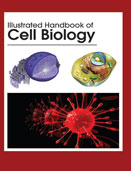Handbooks

Cell biology is the study of cell structure and function, and it revolves around the concept that the cell is the fundamental unit of life. Focusing on the cell permits a detailed understanding of the tissues and organisms that cells compose. Some organisms have only one cell, while others are organized into cooperative groups with huge numbers of cells. This guide focuses on the structure and function of a cell, from the most general properties shared by all cells, to the unique, highly intricate functions particular to specialized cells.
All living organisms on Earth are divided into cells. The main concept of cell theory is that cells are the basic structural unit for all organisms. Cells are small compartments that hold the biological equipment necessary to keep an organism alive and successful. The last two decades the field of cell biology has undergone a veritable revolution, leading to major advances in our understanding of cell structure and function. Cells are the basic building blocks of all living things. The human body is composed of trillions of cells. They provide structure for the body, take in nutrients from food, convert those nutrients into energy, and carry out specialized functions. Cells also contain the body?s hereditary material and can make copies of themselves.
Illustrated Handbook of Cell Biology presents comprehensive introduction to the cell biology and provides essential background information to allow readers to better grasp the subject matter. By understanding how cells work in healthy and diseased states, cell biologists working in animal, plant and medical science will be able to develop new vaccines, more effective medicines, plants with improved qualities and through increased knowledge a better understanding of how all living things live. Eventually it will be possible to produce a ?health forecast? by analyzing the database of genetic and cell information. But cell biology is not just about disease. It has greatly assisted the human fertility program. DNA testing has been used in archaeology to provide evidence that a living person is related to a long dead ancestor. In plant science it has been used to show that two plants that look different have the same genetic origins. Forensic medicine uses cell biology and DNA fingerprinting to help solve murders and assaults. Neither the courts of law nor the criminals can escape the importance of cell biology. Biotechnology uses techniques and information from cell biology to genetically modify crops to produce alternative characteristics; to clone plants and animals; to produce and ensure high quality food is available at lower costs; to produce purer medicines and in time organs for the many people who need transplants. It is also important that everyone feels informed about how the increase in knowledge about cell biology could affect him or her and society in general. Society will have to make informed decisions about such things as growing organs for transplanting into humans.
Illustrated Handbook of Cell Biology provides the study of cell structure and function, Focusing on the cell permits a detailed understanding of the tissues and organisms that cells compose. This Handbook is intended as a Textbook for students and researchers of Life Sciences.